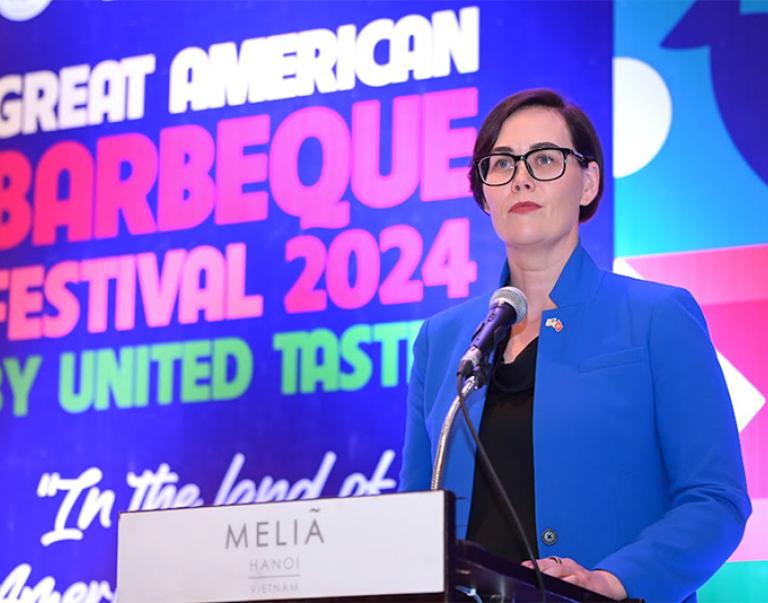WASHINGTON, Oct. 20, 2016 – The U.S. Department of Agriculture (USDA) today announced the availability of up to $16.7 million in competitive grant funding to increase the purchase of fruits and vegetables by families and households participating in the Supplemental Nutrition Assistance Program (SNAP). The funding will be awarded to eligible nonprofits and governmental organizations through the Food Insecurity Nutrition Incentive (FINI) Grant Program, administered by USDA's National Institute of Food and Agriculture (NIFA) authorized by the 2014 Farm Bill.
"Recent data shows that 2015 marked the lowest figures on record for food insecurity among children—a major achievement in our country's efforts to ensure every child has a safer, healthier future filled with unlimited opportunity. In addition, last year 7.9 million fewer people were struggling to provide adequate food for themselves or household members than when President Obama took office in the midst of the worst economic downturn since the Great Depression," said Agriculture Secretary Tom Vilsack. "We must continue to invest in initiatives like the Food Insecurity Nutrition Incentive, which are maximizing SNAP recipients' access to healthy foods and are playing a major role in winning this battle against hunger."
FINI is a joint program between NIFA and USDA's Food and Nutrition Service, which oversees SNAP and is responsible for evaluating the impact of the variety of types of incentive programs being deployed by FINIgrantees. The program brings together stakeholders from different parts of the national food system to improve the nutrition and health status of SNAP households. Since 2015, NIFA has invested $48.3 million to support the work of 58 organizations in 33 states and the District of Columbia through FINI.
Applications may be submitted by eligible government agencies and nonprofit organizations in three categories: pilot projects requesting less than $100,000 over one year, multi-year community-based projects requesting less than $500,000 over no more than four years, and multi-year large-scale projects requesting $500,000 or more over no more than four years. All FINI projects must operate through authorized SNAP retailers and agree to participate in the FINI comprehensive program evaluation.
Priority is given for projects that
- maximize the share of funds used for direct incentives to participants,
- test innovative or promising strategies that will contribute to a better understanding of how best to increase the purchase of fruits and vegetables by SNAP participants,
- develop innovative or improved benefit redemption systems that may be replicated or scaled,
- demonstrate a track record of designing and implementing successful nutrition incentive programs to connect low-income consumers and agricultural producers,
- provide locally or regionally produced fruits and vegetables, especially culturally-appropriate fruits and vegetables for the target households, and
Applications are due by Dec. 12, 2016. See the request for applications for more details.
NIFA will host a free informational webinar for interested applicants on Nov. 3, 2016 at 2:00 p.m., EDT. An archived version will be available on NIFA's FINI webpage following the webinar.
Two previously-funded projects include Market Umbrella in New Orleans and Heritage Ranch, Inc., in Honaunau, Hawaii. Market Umbrella is increasing access to fresh fruits and vegetables for low-income New Orleans residents through the initiation of SNAP incentive programs in a locally- and minority-owned grocery store (Circle Foods) and year-round expansion of incentives at four Crescent City Farmers Markets. Heritage Ranch is testing a new SNAP fresh food incentive project called Buy One Fresh/Get One Local, where each dollar a SNAP user spends on fresh fruit and vegetables is matched with coupons to purchase an equivalent value of local fresh fruits and vegetables from their grocer, grower at a farmers' market or Community Supported Agriculture (CSA) food box.
More information about USDA's efforts to improve access to safe, healthy food for all Americans and supporting the health of our next generation can be found on USDA's Medium chapter, Growing a Healthier Future. Additional information about USDA efforts to support local and regional food systems, including by increasing SNAP access at farmers markets, can be found in the New Markets, New Opportunities Medium chapter.
SNAP—the nation's first line of defense against hunger - helps put food on the table for millions of families experiencing hardship. The program has never been more critical to the fight against hunger. Nearly half of SNAP participants are children and more than 42 percent of recipients live in households in which at least one adult is working but still cannot afford to put food on the table. SNAP benefits provided help to millions who lost their jobs during the Great Recession. For many, SNAP benefits provide temporary assistance, with the average new applicant remaining on the program 12 months.
Since 2009, NIFA has invested in and advanced innovative and transformative initiatives to solve societal challenges and ensure the long-term viability of agriculture. NIFA's integrated research, education and extension programs, supporting the best and brightest scientists and extension personnel, have resulted in user-inspired, groundbreaking discoveries that are combating childhood obesity, improving and sustaining rural economic growth, addressing water availability issues, increasing food production, finding new sources of energy, mitigating climate variability and ensuring food safety.
To learn more about NIFA's impact on agricultural science, visit www.nifa.usda.gov/impacts, sign up for email updates, or follow us on Twitter @usda_NIFA, #NIFAimpacts.
#
USDA is an equal opportunity provider, employer and lender.



